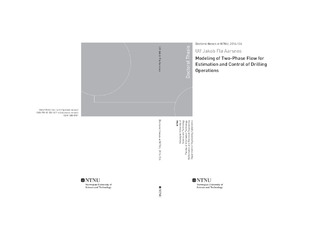| dc.description.abstract | Modern approaches to process monitoring, optimization and control promise enhanced
robustness and performance through the merger of process knowledge encoded
in mathematical models with real-time measurements from the process. Such
design techniques, often referred to as model-based estimation and control, require
a mathematical model with the right balance between complexity and fidelity: i.e.
the complexity must be limited to facilitate the use of established mathematical
analysis and design techniques, while the qualitative response of the process is
retained.
Finding such models amenable for estimation and control of two-phase
flow in
drilling is particularly challenging due to the relative complexity of both the mathematical
models and the dynamics to be represented. In particular the timescale
separation between dominating dynamic effects, distributed nature of important
transport phenomena and the nonlinear coupling between them entails very rich
dynamics with modes over a broad frequency range and bifurcations between potential
operating points.
This thesis uses the classical transient drift
flux model as a starting point for
heuristically distinguishing between three qualitatively different dynamic effects,
each of which dominates the transient response in a given frequency range: ~ 10
seconds, the distributed pressure dynamics, ~ 1- 10 minutes, a slow compressional
pressure mode, and finally ~ 10 minutes to hours, the advection of a two-phase
void wave.
Since the distributed pressure waves operate in a high-frequency range, it is
of little impact for operations concerned with slower phenomena. This insight
is employed to develop simplified model descriptions of the slow pressure mode,
and void wave advection, which are amenable for certain model-based control and
estimation applications. In particular the description is used to develop an RLS
estimator of reservoir pressure during a gas in
flux.
The heuristic for characterizing the dominating effect after frequency range (or
timescale) is also used to develop a robust pressure controller using an automatically
controlled back-pressure choke. The approach retains the dominating dynamic
effect in the frequency range of interest (the slow pressure mode) while ensuring
robustness to the discarded high-frequency pressure waves.
The thesis gives examples from the industry to problems and processes which
can be dealt with through use of model-based estimation and control techniques
and provides a framework for designing such algorithms. | nb_NO |
